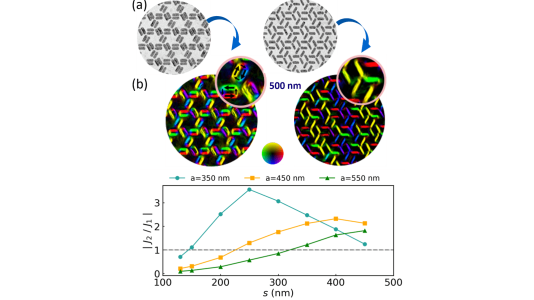
Scientific Achievement
Control of collective ordering of an antiferromagnetic (AF) phase in nanopatterned dimer artificial spin ices.
Significance and Impact
Understanding the antiferromagnetic interactions provides insights into the physics of frustrated antiferromagnets and low-dimensional spin systems.
Research Details
- Artificial spin ice lattices were fabricated by patterning Permalloy nanomagnet dimers on a Kagome lattice using electron beam lithography.
- The magnetic state of individual nanomagnets and the inter-island coupling were visualized directly using LTEM, showing a geometry-dependent antiferromagnetic phase in the lattices.
- Using micromagnetic modeling, and Monte Carlo simulations based on a Hamiltonian dipolar model, we quantitatively understand the competing local interactions that govern the emergence of a short-range ordered AF state wherein the vertex magnetic charge is uniform.
Argonne National Laboratory seeks solutions to pressing national problems in science and technology. The nation’s first national laboratory, Argonne conducts leading-edge basic and applied scientific research in virtually every scientific discipline. Argonne researchers work closely with researchers from hundreds of companies, universities, and federal, state and municipal agencies to help them solve their specific problems, advance America’s scientific leadership and prepare the nation for a better future. With employees from more than 60 nations, Argonne is managed by UChicago Argonne, LLC for the U.S. Department of Energy’s Office of Science.
The U.S. Department of Energy’s Office of Science is the single largest supporter of basic research in the physical sciences in the United States and is working to address some of the most pressing challenges of our time. For more information, visit https://energy.gov/science.